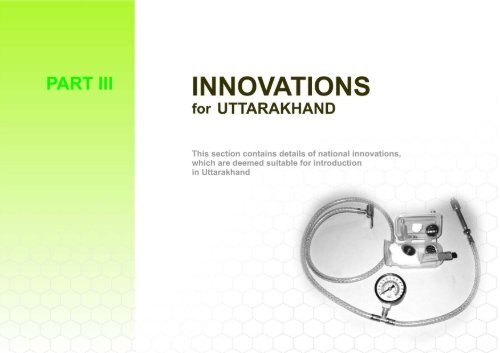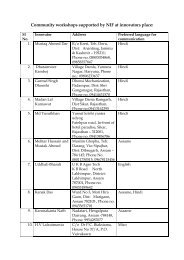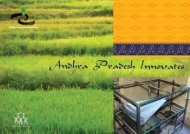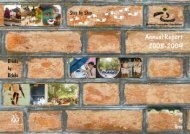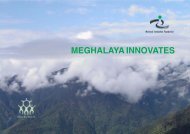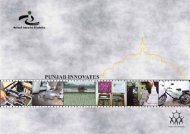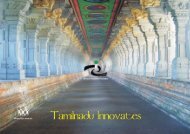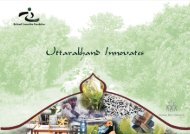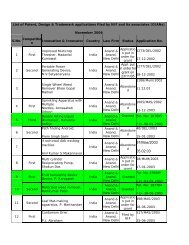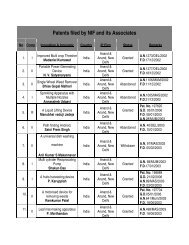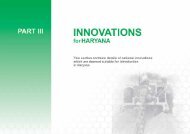part iii UTTARAKHAND.pdf - National Innovation Foundation
part iii UTTARAKHAND.pdf - National Innovation Foundation
part iii UTTARAKHAND.pdf - National Innovation Foundation
Create successful ePaper yourself
Turn your PDF publications into a flip-book with our unique Google optimized e-Paper software.
01<br />
PART III : INNOVATIONS FOR <strong>UTTARAKHAND</strong><br />
HMT- an Improved Paddy Variety<br />
Dadaji Ramaji Khobragade<br />
Maharashtra<br />
Khobragade selected and bred the HMT rice variety from the conventional ‘Patel 3’, a<br />
popular variety developed by Dr. J. P. Patel, JNKV Agriculture University, Jabalpur. He<br />
succeeded after five years of continuous study and research on a small farm owned by<br />
him without any support from the scientific community. This varierty has an average yield<br />
of 40 – 45 quintals per hectare with short grains, high rice recovery (80 %), better smell<br />
and cooking quality in comparison with the parent ones. Most remarkable feature of the<br />
variety is the thinness of grain. It has been included as a standard reference for thinness<br />
by Protection of Plant Variety and Farmers’ Right Authority (PPVFRA).<br />
He won the <strong>National</strong> Award in NIF’s Third <strong>National</strong> Competition. NIF has filed an<br />
application under PPVFRA 2001 to register his variety. A<strong>part</strong> from HMT he has also<br />
developed six other paddy varieties namely DRK, Vijay Anand, Nanded Chinur, Nanded<br />
92, Deepak Ratna and Nanded Hira. He regrets that local agricultural university took the<br />
credit merely for purifying the seeds and did not give him the due honour. HMT has diffused<br />
in more than one lac acres in five states.<br />
<strong>UTTARAKHAND</strong> INNOVATES 54
PART III : INNOVATIONS FOR <strong>UTTARAKHAND</strong><br />
02<br />
Kudrat 9- An Improved Variety of Wheat<br />
The innovator believes that every farmer should get good quality seeds to deliver high<br />
yielding varieties of crops. He has developed a number of improved wheat, paddy, mustard<br />
and pigeon pea varieties, which are high yielding, robust stem, having bold seeds with<br />
good smell, taste and which are resistant to major pests & diseases.<br />
“Kudat 9”, an improved wheat variety, developed by him using simple selection is quite<br />
popular among the farmers in different <strong>part</strong>s of Uttar Pradesh, Madhya Pradesh,<br />
Chattisgarh, Maharashtra, Rajasthan, Gujarat and some <strong>part</strong>s of Bihar, Haryana and<br />
Punjab. This variety bears large number of ear tillers with lengthy spikes and has a hardy<br />
stem. The grain has a good taste. The average yield of this variety is 55-60 quintals /<br />
hectares.<br />
Prakash Singh<br />
Raghuvanshi<br />
Uttar Pradesh<br />
<strong>UTTARAKHAND</strong> INNOVATES 55
03<br />
PART III : INNOVATIONS FOR <strong>UTTARAKHAND</strong><br />
Virat (JP-6)- An Improved Variety of Pigeon pea<br />
Jai Prakash Singh<br />
Uttar Pradesh<br />
This new variety has coloured flowers, long leaves and bunchy type pods bearing at the<br />
top. The seed weight (19 – 20 gram/ 100 seeds), number of pods / plant (500 - 600), big<br />
size pods (3 – 5 inch), number of seeds/pod (5 – 6) and perennial yield (1st year 12 -14<br />
quintal/ acre and 2nd year 14 – 15 quintal/ acre) is higher as compared to the local<br />
popular variety. This variety requires less quantity of seed (4 – 5 kg/acre) and maintenance<br />
as compared to other varieties grown in the region.<br />
<strong>UTTARAKHAND</strong> INNOVATES 56
PART III : INNOVATIONS FOR <strong>UTTARAKHAND</strong><br />
04<br />
Richa 2000- An Improved Variety of Pigeon pea<br />
This variety has big flowers, long leaves and bunchy type pod bearing at the top. Topping<br />
is done periodically, which results in bushy growth. This variety has synchronous maturity<br />
with higher yield (24 quintals/acre), more branches / plant (12-14) and more pods/plant<br />
(700 – 800) than other local popular varieties of the region. Rathore was given a<br />
consolation award in NIF’s Fourth <strong>National</strong> Biennial Competition.<br />
Rajkumar Rathore<br />
Madhya Pradesh<br />
<strong>UTTARAKHAND</strong> INNOVATES 57
05<br />
PART III : INNOVATIONS FOR <strong>UTTARAKHAND</strong><br />
Herbal Growth Promoter<br />
A herbal plant growth promoter, which is effective in protecting the plants from a broad<br />
spectrum of pests a<strong>part</strong> from providing necessary nutrition has been developed. It is named<br />
as “Kamaal” meaning wonderful, due to its performance. It is effective in field crops as<br />
well as in vegetable crops.<br />
Ishwar Singh Kundu<br />
Haryana<br />
The main ingredients of the product are “aak” (Calotropis gigantea), “reetha” (Sapindus<br />
trifoliatus), “dhatura” (Datura metel), “neem” (Azadirachta indica), Tobacco (Nicotiana<br />
tabacum), and “bhang” (Cannabis sativa), etc.<br />
The innovator won a consolation award in NIF’s Fourth <strong>National</strong> Biennial Competition.<br />
He has also been supported under the Micro Venture <strong>Innovation</strong> Fund of NIF for<br />
commercialising “Kamaal”. The product is a good hit in the local market and is fetching<br />
steady income for the innovator. This product has also been supplied to the garden in<br />
Rashtrapati Bhavan.<br />
<strong>UTTARAKHAND</strong> INNOVATES 58
PART III : INNOVATIONS FOR <strong>UTTARAKHAND</strong><br />
06<br />
Aloe vera Gel Extractor<br />
The innovator has developed an effective multipurpose unit capable of pulverizing,<br />
steaming, and extraction of gel for herbal applications.<br />
With this device, the innovator uses the specially designed pressure cooking chamber to<br />
extract the essence from Aloe vera. Being a compact portable unit, it can be quickly and<br />
easily transported and used anywhere, to process herbs and deliver on demand. The<br />
present machine has a capacity to process 100 kg of Aloe vera per hour. The innovator<br />
was supported for production and commercialisation through GIAN North from the Micro<br />
Venture <strong>Innovation</strong> Fund at NIF. One unit has been sent to Kenya on a pilot basis for<br />
application feasibility study in the country.<br />
Dharamveer<br />
Haryana<br />
<strong>UTTARAKHAND</strong> INNOVATES 59
07<br />
PART III : INNOVATIONS FOR <strong>UTTARAKHAND</strong><br />
Modifications in Gears for Mountainous Slope<br />
Anybody who has driven on mountainous roads knows that while descending on the<br />
slopes, one needs a kind of locking mechanism in the gear to prevent slippages. Kamal<br />
Narayan has modified the old gears which may get worn out and may cause accidents if<br />
not replaced or repaired.<br />
Kamal Narayan<br />
Pradhan ‘Gorkha’<br />
Himachal Pradesh<br />
He has modified the gear arrangement to prevent slippage even in the new vehicles.<br />
This innovation has been found very useful by the heavy vehicle drivers. Its dissemination,<br />
however, is localised.<br />
<strong>UTTARAKHAND</strong> INNOVATES 60
PART III : INNOVATIONS FOR <strong>UTTARAKHAND</strong><br />
08<br />
Modified Hydro Electricity Turbine<br />
Electricity supply in the hills is always a problem with either the difficulty of access or<br />
distribution or disruption.<br />
Hydro electric turbine is specifically designed for the hills. It costs Rs.30,000 and meets<br />
the individual electric needs of a rural household. The innovator has installed a few of<br />
these turbines in the hilly villages of Karnataka.<br />
G. K. Ratnakar<br />
Karnataka<br />
<strong>UTTARAKHAND</strong> INNOVATES 61
09<br />
PART III : INNOVATIONS FOR <strong>UTTARAKHAND</strong><br />
Hand Operated Water Lifting Device<br />
An efficient way of pumping water to meet requirements in a cost effective way is always<br />
a challenge in rural India.<br />
N Sakthimainthan<br />
Tamil Nadu<br />
Developed from locally available materials, this hand operated water lifting device is<br />
simple in design, delivers high discharge and is low cost compared to conventional hand<br />
pump, bucket pump, and bicycle operated pumps. It costs approximately two thousand<br />
rupees. This innovation was awarded in NIF’s Fourth <strong>National</strong> Biennial Competition.<br />
This innovation was also selected for value addition by CMERI, Durgapur under<br />
Mechanical Joint Implementation Committee (JIC) of CSIR-NIF.<br />
<strong>UTTARAKHAND</strong> INNOVATES 62
PART III : INNOVATIONS FOR <strong>UTTARAKHAND</strong><br />
10<br />
Improved Multicrop Thresher<br />
Farmers across India require a reliable machine that achieves threshing with minimal<br />
grain breakage, clean output for a variety of crops. The innovator has developed a versatile<br />
thresher that can meet these needs.<br />
The modified farm implement reduces setup time to less than 15 minutes to switch over<br />
from one crop to another, and achieves minimal breakage. Its latest variant can also<br />
handle groundnut a<strong>part</strong> from threshing other cereals and pulses.<br />
The innovator has been supported with working capital needs of his enterprise under the<br />
Micro Venture <strong>Innovation</strong> Fund of NIF. More than a hundred farmers have bought his<br />
thresher.<br />
Madanlal Kumawat<br />
Rajasthan<br />
<strong>UTTARAKHAND</strong> INNOVATES 63
11<br />
PART III : INNOVATIONS FOR <strong>UTTARAKHAND</strong><br />
Two-wheeler Based Spray Painting Device<br />
Sheikh Jahangir Sheikh<br />
Usman<br />
Maharashtra<br />
The innovation is a painting device that can be easily mounted on a two-wheeler scooter<br />
and carried to a customer’s place. Deriving power from the two-wheeler’s engine to run the<br />
compressor, this device lends flexibility of usage to the painter. This innovation won Sheikh<br />
Jahangir a consolation prize in NIF’s Fourth <strong>National</strong> Competition. NIF has also filed a<br />
patent application for the same and has supported him through the Micro Venture<br />
<strong>Innovation</strong> Fund. He has also made a scooter based washing machine and a scooter<br />
mounted flour mill.<br />
<strong>UTTARAKHAND</strong> INNOVATES 64
PART III : INNOVATIONS FOR <strong>UTTARAKHAND</strong><br />
12<br />
Portable Painting System<br />
Often, users need a small portable spray painting system to meet local needs including<br />
indoors. Gurjeet has developed such a system using available <strong>part</strong>s such as compressor,<br />
air tank and a spray gun.<br />
Weighing hardly ten kilograms and costing one-third of the commercial systems, it works<br />
very well. By using a tube in place of air tank, the innovator projects that the cost can be<br />
reduced for certain type of jobs.<br />
Gurjeet Singh<br />
Himachal Pradesh<br />
<strong>UTTARAKHAND</strong> INNOVATES 65
13<br />
PART III : INNOVATIONS FOR <strong>UTTARAKHAND</strong><br />
Auto Air Kick Pump<br />
This innovation is a low cost, portable, compact aid to inflate tyre tubes/punctures of any<br />
vehicle having kick start or auto start mechanism so as to fix the problem on the spot and<br />
enable the rider to reach the nearby gas station or repair shop.<br />
Arvindbhai Patel<br />
Gujarat<br />
This device converts the compressor into an air pump. A pinch of polymer granules is<br />
also inserted to seal the leakage in the tube. The user can kick and fill air in the tube.<br />
This may last for a few kilometers to reach a pump repairing shop. An entrepreneur from<br />
Mumbai has licensed this technology and has sold more than 2500 pieces so far, mainly<br />
in North Eastern India through another technology licensing initiated by NIF North East<br />
cell at IIT Guwahati.<br />
<strong>UTTARAKHAND</strong> INNOVATES 66
PART III : INNOVATIONS FOR <strong>UTTARAKHAND</strong><br />
14<br />
Safe Wood Cutting Machine<br />
The innovator has developed a diagonal cutting system, which enables cutting at different<br />
angles. The machine uses a 2HP motor, transmission system, rotating platform, and<br />
saw blade with a simple elegant construction. It consists of a moving platform to feed the<br />
job, while being able to fix and cut the job in any orientation. It also has facilities to mount<br />
multiple fixtures using an inbuilt scale for measurement and productivity enhancement.<br />
Kishanlal Jangid<br />
Rajasthan<br />
<strong>UTTARAKHAND</strong> INNOVATES 67
15<br />
PART III : INNOVATIONS FOR <strong>UTTARAKHAND</strong><br />
Panihari - A Head Load Reducing Device<br />
Rural women walk tens of miles with heavy load on their head, which causes stress,<br />
discomfort and eventually head and neck injuries.<br />
Khimjibhai Kanadia<br />
Gujarat<br />
The product is an ergonomically designed device fixed on top of the head, with two extended<br />
supporting rods from the sides of the device. The device transfers the weight carried on the<br />
head to the shoulders, which is better positioned to carry weight.<br />
<strong>UTTARAKHAND</strong> INNOVATES 68
PART III : INNOVATIONS FOR <strong>UTTARAKHAND</strong><br />
16<br />
Jalpari- The Water Carrier<br />
Women who walk miles with heavy water pitchers on their head, suffer discomfort and<br />
even injuries. This innovation consists of a shoulder slung unit fixed with water canisters<br />
balanced on either side.<br />
The carrier has two washable plastic containers of 20 liters capacity in the front and the<br />
back respectively. Metallic handle grips for holding and picking, a soft flexible shoulder<br />
strap and a tap for taking out water are some of the features of this versatile unit.<br />
Madhav Sawant<br />
Maharashtra<br />
<strong>UTTARAKHAND</strong> INNOVATES 69
17<br />
PART III : INNOVATIONS FOR <strong>UTTARAKHAND</strong><br />
Sanitary Napkin Making Machine<br />
Sanitary napkins, a universally needed product, have a very low penetration in India due<br />
to high price and the traditional trend of using cheaper but unhygienic old cloth pieces.<br />
The innovator has developed a machine that produces quality sanitary napkins at a low<br />
cost.<br />
A. Muruganandam<br />
Tamil Nadu<br />
One can prepare sanitary napkins with standard material while cutting down the cost in<br />
production. It requires three to four persons to produce two pads per minute. Costing less<br />
than half of conventional options, this machine produces sanitary pads @ Rs.1 to Rs.<br />
1.50 per pad approximately.<br />
The innovator prefers to sell the napkin making machinery only to self-help groups of<br />
women. He has also designed a napkin vending machine such that one can put a coin<br />
and get a pad. With the support from the Micro Venture <strong>Innovation</strong> Fund scheme, the<br />
innovator has been able to install fifty units in seven states.<br />
<strong>UTTARAKHAND</strong> INNOVATES 70
PART III : INNOVATIONS FOR <strong>UTTARAKHAND</strong><br />
18<br />
Garlic Peeling & Lemon Cutting Machine<br />
Faster peeling of garlic in an effective way is a major requirement in the pickle industry.<br />
This product is a food-grade, fully automated machinery designed for bulk quantity peeling<br />
of garlic. The machine ensures minimal damage and has wide application in making<br />
pickles and herbal medicines. The machine is energy efficient, saves labour, needs low<br />
capital and operating cost. It frees the industry from capacity constraints caused by<br />
shortage of labour in peak seasons.<br />
The second product is also used in pickle industry, but for cutting lemons. It is a cost<br />
effective machine, having innovative design, with continuous feeding system. It performs<br />
precise and standard cutting of large quantity of lemons in uniform shape and sizes. It<br />
can be operated by one person and cuts lemon into maximum eight pieces. The innovator<br />
has been supported under MVIF scheme and has achieved a turn over of around sixty<br />
lakhs since 2003.<br />
M. Nagarajan<br />
Tamil Nadu<br />
<strong>UTTARAKHAND</strong> INNOVATES 71
19<br />
PART III : INNOVATIONS FOR <strong>UTTARAKHAND</strong><br />
Beauty Care Umbrella<br />
Protection from harsh rays of the sun is a requirement in most <strong>part</strong>s of a tropical country<br />
like India. An umbrella made from traditional yet multifaceted material is a boon for the<br />
common man.<br />
Dulal Choudhary<br />
Assam<br />
This innovative umbrella is durable, stain free, water proof and is produced from muga<br />
silk. It has a pleasing golden shine, which illuminates colour and protects from UV<br />
radiations up to 80 percent as per laboratory tests, far better than that offered by<br />
conventional umbrellas. NIF had facilitated the technology licensing of the innovation to<br />
Assam Silk Development Centre in 2005. The product has been sold to customers in<br />
Europe and Australia also.<br />
<strong>UTTARAKHAND</strong> INNOVATES 72
PART III : INNOVATIONS FOR <strong>UTTARAKHAND</strong><br />
20<br />
Mobile Operated Switch and Multi-media Poster<br />
Imagine a village where the farmer has the luxury of being able to stay at home and<br />
switch his irrigation pump in the faraway field on or off as required during the day or at<br />
night. This is made possible by this brilliant innovation, which uses the power of mobile<br />
telephony to trigger electrical control switches.<br />
The farmer can remotely know the status of the pump in his cell phone and turn the<br />
motor on or off by calling the <strong>part</strong>icular configured number. It activates the switching by<br />
certain number of rings and hence incurs no call charges. Prem Singh has developed<br />
several other innovations, one of which is the viewer triggered multi-media poster. If any<br />
agency wants to communicate some graphic message with different language audios<br />
or videos, this multi-media poster can be very useful.<br />
Prem Singh Saini<br />
Haryana<br />
<strong>UTTARAKHAND</strong> INNOVATES 73
End Notes & References<br />
1) Jain, S.P. and Verma, D.M. 1981. Medicinal Plants in the folklore of North-East Haryana. Nat. Acad. Sci. Lett. 47: 269-271.<br />
2) Cantoria, M. 1976. Aromatic and Medicinal Herbs of the Philippines. Qut. Jour. Crude Drug Res. 14: 97-128.<br />
3) Jain, S.K. 1991. Dictionary of Indian Folk Medicine and Ethnobotany, New Delhi, Deep Publication, pp. 1-311.<br />
4) SBL Homoeopathy Clinic, http://www.sblglobal.com/tranquil.html, downloaded on 04.11.2008.<br />
5) Kinghorn, A.D. and Choi, Young-Hee.1993. Natural intense sweeteners. Research Corporation Technologies, Inc. (Pat no.5198427 dt.09.07.1990; http://patft.uspto.gov,<br />
downloaded on 04.11.2008)<br />
6) Das, P.C. 1976. Oral contraceptive long-acting- method of and system for determining the rate of an electronic . (Pat no. GB1445599 dt.11.08.1976; http:// v3.espacenet.com,<br />
downloaded on 04.11.2008)<br />
7) Akhtar, M.S. 1992. Hypoglycaemic activities of some indigenous medicinal plants traditionally used as antidiabetic drugs. J. Pak. Med. Ass. 42 (11): 271-277.<br />
8) Reddy, M.B., Reddy, K.R. and Reddy, M.N. 1989. A survey of plant crude drugs of Anantapur district, Andhra Pradesh, India. Int. J. Crude Drug Res. 27(3): 145-155.<br />
9) Zagari, A. 1992. Medicinal plants. Vol. 4. (5th ed.) Tehran, Iran. Tehran University Publications, p. 969.<br />
10) Himalaya healthcare products, http://www.himalayahealthcare.com/products.htm, downloaded on 20.08.2008.<br />
11) Guangkui, Z. 2008. Chinese traditional medicine preparation for curing laryngopharyngitis. Hunan Times Sunlight Pharmaceu (CN). (Pat no. CN101116680 dt. 06.02.2008;<br />
http: //v3.espacenet.com, downloaded on 20.08.2008).<br />
12) Muthuswamy, M.P. 2003. Polyherbal composition for the treatment of Bronchial Asthma and the process. Dalmia C.T. for Res and Dev (IN) and Murali Panchapagesa<br />
Muthuswamy (IN). (Pat no. WO03055558 dt.10.07.2003; http://v3.espacenet.com, downloaded on 20.08.2008).<br />
13) Bhattarai, N.K. 1994. Folk herbal remedies for gynaecological complaints in Central Nepal. Int. J. Pharmacog. 32 (1): 13-26.<br />
14) Shrivastava, R.K. 1985. Aegle marmelos: An Ipso Facto plant of India. J. Res. Edu. Ind. Med. 4 (3/4): 21-25.<br />
15) Bazar of India herbal products, http://www.bazaarofindia.com/productsnew.asppid=100K38&catid=BC&subcatid=CL, downloaded on 04.08.2008.<br />
16) Pushpangadan, P. and Dhan, P. 2006. Herbal nutraceutical formulation for diabetics and process for preparing the same. CSIR, New Delhi. (Pat no. 7014872 dt.<br />
21.03.2006; http://patft.uspto.gov, downloaded on 20.08.2008).<br />
17) Rao, J.M., Sampathkumar, U., Sastry, B.S., Yadav, J.S., Raghavan, K.V., Palit, G., Rai, D., Varier, P.M., Muraleedharan, T.S. and Muraleedharan, K. 2003. Composition<br />
for treating gastric ulcer and a process for preparing the same. (Pat no. 20030180398 dt. 25.09.2003; http://www.freepatentsonline.com, downloaded on 20.08.2008).<br />
18) Manandhar, N.P. 1995. An inventory of some herbal drugs of Myagdi district, Nepal. Econ. Bot. 49 (4): 371-379.<br />
19) Khan, M.A. and Singh, V.K. 1996. A folklore survey of some plants of Bhopal district forests, Madhya Pradesh, India, described as antidiabetics. Fitoterapia. 67 (5): 416-<br />
421.<br />
20) Manandhar, N.P. 1994. An ethnobotanical survey of herbal drugs of Kaski district, Nepal. Fitoterapia. 65 (1): 7-13.<br />
21) http://www.aggarwaloverseas.com/HerbalDetail.aspxProductID=283, downloaded on 04.08.2008.<br />
22) Inomata, S., Umishio, K., Kobayashi, K., Satake, M., Sekida, S. and Takano, A. 2003. Matrix Metalloprotease Activity Inhibitor and Skin Care Preparation. Shiseido Co. Ltd.<br />
(Pat no. JP2003201212 dt. 18.07.2003; http://v3.espacenet.com, downloaded on 20.08.2008).<br />
23) Lai, Z. and Huang, X. 2008. Pharmaceutical composition comprising a combination of Chinese traditional medicines. Beijing Qijieyuan Pharmaceutical Technology<br />
Development Co. Ltd. (Pat no. 7381430 dt. 03.05.2008; http://patft.uspto.gov, downloaded on 20.08.2008).<br />
24) Al-Yahya, M.A. 1986. Phytochemical studies of the plants used in traditional medicine of Saudi Arabia. Fitoterapia. 57 (3): 179-182.<br />
25) Anis, M. and Iqbal, M. 1986. Antipyretic utility of some Indian plants in traditional medicine. Fitoterapia. 57 (1): 52-55.<br />
26) Sebastian, M.K. and Bhandari, M.M. 1984. Medico-ethno botany of Mount Abu, Rajasthan, India. J. Ethnopharmacol. 12 (2): 223-230.<br />
27) Herbalcure India, http://www.herbalcureindia.com/herbs/arka.htm, downloaded on 17.11.2008<br />
28) Kiss, R. 2005. Extract with anti-tumor and anti-poisonous activity. Unibioscreen S.A., Belgium (Pub no. MXPA05003634 (A) dt. 14.12.2005; http://v3.espacenet.com,<br />
downloaded on 21.11.2008)<br />
29) Duke, J.A. and Vasquez, R. 1994. Amazonian Ethnobotanical Dictionary, CRC Press, Boca Raton. p. 181.<br />
30) Coee, F.G. and Anderson, G.J. 1996. Ethnobotany of the Garifuna of Eastern Nicaragua. Econ. Bot. 50 (1): 71-107.<br />
31) Gupta, M.P., Arias, T.D., Correa, M. and Lamba, S.S. 1979. Ethnopharmacognositc observations on Panamanian medicinal plants. Part I. Q. J. Crude Drug Res. 17 (3/4):<br />
115-130.<br />
<strong>UTTARAKHAND</strong> INNOVATES 74
32) Wild crafted herbal products, http://www.wildcrafted.com.au/ downloaded on 22.08.2008.<br />
33) Agarwal, R.K. and Agarwal, A. 2004. Herbal composition having antiallergic properties and a process for the preparation thereof. Bangalore, Natural Remedies Pvt. Ltd.<br />
(Pat no. 6730332 dt.04.05.2004; http://patft.uspto.gov, downloaded on 23.08.2008).<br />
34) Morimoto, C. and Dang, N.H. 2006. Compositions for cancer prevention, treatment, or amelioration comprising papaya extract. (Pub no.WO/2006/004226 dt. 12.01.2006;<br />
http://www.wipo.int/pctdb/en/wo.jsp, downloaded on 23.08.2008).<br />
35) Adesina, S.K. 1982. Studies on some plants used as anticonvulsants in Amerindian and African traditional medicine. Fitoterapia 53: 147-162.<br />
36) Panthong, A., Kanjanapothi, D. and Taylor, W.C. 1986. Ethnobotanical review of medicinal plants from Thai traditional books, Part 1: plants with antiinflammatory,<br />
antiasthmatic and antihypertensive properties. J. Ethnopharmacol. 18 (3): 213-228.<br />
37) Prajapati, N.D., Purohit, S.S., Sharma, A.K. and Kumar, T. 2007. A Handbook of Medicinal Plants, Jodhpur, Agrobios (India), Section II.pp.1-554.<br />
38) Arvind Herbal Labs (P) Limited, http://www.tradeindia.com/ downloaded on 29.08.2008.<br />
39) Enrico, D.V., Antonio, P., Chiara, C., Luisa, G., Gianfranco, M. and Emanuella, M. 2008. A novel use of antidepressant compounds and related compositions. Medestea<br />
Internazionale S.P.A., Italy. (Pub no. WO/2008/078353 dt. 03.07.2008; http://www.freepatentsonline.com, downloaded on 29.08.2008).<br />
40) Wasuwat, S. 1967. A list of Thai medicinal plants, ASRCT, Bangkok. Research Report, A.S.R.C.T., no.1 on research project 17: p. 22.<br />
41) Kar, A., Choudhary, B.K. and Bandyopadhyay, N.G. 1999. Preliminary studies on the inorganic constituents of some indigenous hypoglycaemic herbs on oral glucose<br />
tolerance test. J. Exp. Bot. 64 (2): p. 179-184.<br />
42) Mokkhasmit, M., Ngarmwathana, W., Sawasdimongkol, K. and Permphiphat, U. 1971. Pharmacological evaluation of Thai medicinal plants. J. Med. Ass. Thailand. 54 (7):<br />
490-504.<br />
43) http://www.dabur.com/en/search/welcome.aspq=tricawin, downloaded on 07.01.2009.<br />
44) http://www.allayurveda.com/db/salableproducts.aspcurrentPage=4, downloaded on 07.01.2009.<br />
45) Pushpangadan, P., Venkateswara, R.C., Raghavan, G., Mehrotra, S. and Nair; R.K. 2008. Method for treating stomach ulcers with herbal extract composition. CSIR,<br />
New Delhi, India. (Pat no. 7,438,932, dt. 21.10.2008; http://patft.uspto.gov, downloaded on 22.12.2008).<br />
46) Sahu, T.R. 1984. Less known uses of weeds as medicinal plants. Ancient. Sci. Life. 3 (4): 245-249.<br />
47) Bhandary, M.J., Chandrashekar, K.R. and Kaveriappa, K.M. 1995. Medical ethnobotany of the Siddis of Uttara Kannada district, Karnataka, India. J. Ethnopharmacol.<br />
47(3):149-158.<br />
48) Martinez, M.A. 1984. Medicinal plants used in a Totonac community of the Sierra Norte de Puebla: Tuzamapan de Galeana, Puebla, Mexico. J. Ethnopharmacol.<br />
11(2):203-221.<br />
49) Natural skin Care, http://www.drhauschka.co.uk, downloaded on 08.11.2008.<br />
50) Kamata Y., Toyokawa, T., Teruya, M. and Ichiba T. 2005. Anti-obesity agent having lipase inhibiting activity and antioxidation activity. Okinawa Prefecture. (Pat no.<br />
JP2005060334 (A) dt.10.03.2005; http://v3.espacenet.com downloaded on 08.11.2008)<br />
51) Spring, M.A. 1989. Ethnopharmacologic analysis of medicinal plants used by Laotian Hmong refugees in Minnesota. J. Ethnopharmacol. 26 (1): 65-91.<br />
52) Hwang, Shie-Ming. 2001. Process for preparing an anti-viral medicinal product from plant extracts. Sage R&D, Columbus, USA. (Pat no. 6214350 dt. 10.04.2001;<br />
http://patft.uspto.gov, downloaded on 25.08.2008).<br />
53) Tsai, Hsiu-Hsien, Hwang, Shie-Ming and Kung, Pai-Chu. 1998. Use of plant extracts for treatment of HIV, HCV and HBV infections. Sage R&D, Columbus, USA. (Pat no.<br />
5837257 dt.17.11.1998; http://patft.uspto.gov, downloaded on 25.08.2008).<br />
54) Singh, V.K. and Ali, Z.A. 1992. A contribution to the ethnopharmacological study of the Udaipur forests of Rajasthan, India. Fitoterapia 63 (2): 136-144.<br />
55) Nagaraju, N. and Rao, K.N. 1990. A survey of plant crude drugs of Rayalaseema, Andhra Pradesh, India. J. Ethnopharmacol. 29 (2): 137-158.<br />
56) Gupta, S., Yadava, J.N.S. and Tandon, J.S. 1993. Antisecretory (antidiarrhoeal) activity of Indian medicinal plants against Escherichia coli enterotoxin-induced secretion<br />
in rabbit and guinea pig ileal loop models. Int. J. Pharmacog. 31 (3): 198-204.<br />
57) Pushpangadan, P., Rao, Ch.V., Rawat, A.K.S., Ojha, S.K. and Reddy, G.D. 2008. Anti-allergic herbal formulation. CSIR, New Delhi. (Pat no. 7344739 dt. 28.12.2004; http:/<br />
/patft.uspto.gov downloaded on 22.10.2008).<br />
58) Solanki, R.S. 2003. Herbal formulation. Sahajanand Biotech Private Ltd, India. (Pub no. GB2378384 dt. 12.02.2003; http://v3.espacenet.com, downloaded on 23.10.2008).<br />
59) Gurib-fakim, A., Sweraj, M.D., Gueho, J. and Dulloo, E. 1996. Medicinal plants of Rodrigues. Int. J. Pharmacog. 34 (1): 2-14.<br />
60) Arya herbal products, http://www.aryaherbal.com/dhanwantaram.php downloaded on 29.06.2008.<br />
61) Pezzuto, J.M., Dasgupta, T.K., Kim-Darrick, S.H.L., Schmidt, M.L., Kuzmanoff, K. M. and Ling-Indeck, L. 2000. Method and composition for treating cancers. Board of<br />
trustees of University of Illinois, USA. (Pub no. EP0981342, dt. 01.03.2000; http://v3.espacenet.com downloaded on 18.01.2009).<br />
<strong>UTTARAKHAND</strong> INNOVATES 75


